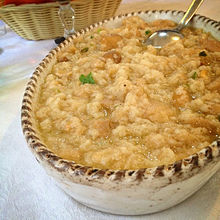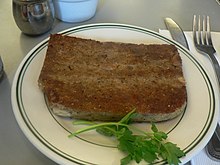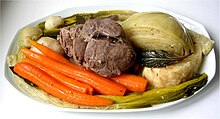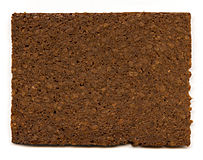| This article needs additional citations for verification. Please help improve this article by adding citations to reliable sources. Unsourced material may be challenged and removed. Find sources: "Peasant foods" – news · newspapers · books · scholar · JSTOR (March 2014) (Learn how and when to remove this message) |

Peasant foods are dishes eaten by peasants, made from accessible and inexpensive ingredients.
In many historical periods, peasant foods have been stigmatized.
Common types
Meat-and-grain sausages or mushes

Ground meat or meat scraps mixed with grain in approximately equal proportions, then often formed into a loaf, sliced, and fried
- Balkenbrij
- Black pudding
- Boudin
- Goetta, a pork or pork-and-beef and pinhead oats sausage
- Groaty pudding
- Haggis, a savory dish containing sheep's pluck (heart, liver, and lungs), minced with onion, oatmeal, suet, spices, and salt, mixed with stock, and cooked while encased in a sheep's stomach
- Knipp
- Livermush
- Lorne sausage
- Meatloaf
- Scrapple, pig scraps, cornmeal and other flours and spices fried together in a mush
- Slatur
Pasta
- Pasta con i peperoni cruschi, an Italian pasta dish from Basilicata, defined a true representative of cucina povera ('the cuisine of the poor')
- Pasta e fagioli, a traditional Italian pasta soup
- Pasta mollicata, Italian pasta dish from southern Italy, especially Basilicata, often known as a "poor man's dish"
- Testaroli
Sauces

- Agliata – a garlic sauce in Italian cuisine that has been a peasant food, and also used by upper-class people
Soups and stews

- Acquacotta, an Italian soup that dates to ancient history. Primary ingredients are water, stale bread, onion, tomato and olive oil, along with various vegetables and leftover foods that may have been available.
- Batchoy (Tagalog), a Filipino meat soup or noodle soup made with pork and pork offal in ginger-flavored broth, traditionally with pork blood added
- Cassoulet, a French bean, meat, and vegetable stew originating from the rural Southwest that has since become a staple of French cuisine
- Cawl, a Welsh broth or soup
- Cholent, a traditional Jewish Sabbath stew
- Chupe, refers to a variety of stews from South America generally made with chicken, red meat, lamb or beef tripe and other offal
- Duckefett, a German sauce
- Dinuguan, a Filipino pork blood stew infused with vinegar
- Feijoada, originally a Portuguese stew consisting of beans and meat; also a Brazilian dish originally made by slaves from leftover ingredients from their master's house
- Gazpacho, typically a tomato-based vegetable soup, traditionally served cold, originating in the southern Spanish region of Andalusia
- Minestrone, the meal in one pot of ancient Italy that is still a basic part of Italian cuisine
- Mulligan stew, a stew often made by itinerant workers
- Mujaddara, an Arabian dish of lentils, rice, grains, and onions
- Pappa al pomodoro, a bread soup typically prepared with tomatoes, bread, olive oil, garlic, and basil
- Pea soup or "pease pudding", a common thick soup, from when dried peas were a very common food in Europe, still widely eaten there and in French Canada
- Pot-au-feu, the French stew of oxtail, marrow, and vegetables, sometimes sausage
- Pottage, a staple stew made from boiling vegetables, grains and whatever was available, since Neolithic times in the British Isles
- Ratatouille, a French stewed vegetable dish
- Shchi, a traditional Russian soup made from cabbage, meat, mushrooms, flour and sour cream, usually eaten with rye bread
- Scouse (food), a stew type dish from Liverpool, which gives its name to the residents of the city, who are known as scousers
- Zatiruha, an Eastern European soup
List of peasant foods
| This section may contain unverified or indiscriminate information in embedded lists. Please help clean up the lists by removing items or incorporating them into the text of the article. (October 2018) |

- Baked beans, the simple stewed bean dish
- Barbacoa, a form of slow cooking, often of an animal head, a predecessor to barbecue
- Bulgur wheat, with vegetables or meat
- Broken rice, which is often cheaper than whole grains and cooks more quickly
- Bubble and squeak, a simple British dish, cooked and fried with potatoes and cabbage mixed together
- Finger millet balls made from ragi flour which is boiled with water and balls are formed and eaten with vegetable gravy
- Greens, such as dandelion and collard
- Head cheese, made from boiling down the cleaned-out head of an animal to make broth, still made
- Hominy, a form of corn specially prepared to be more nutritious
- Horsebread, a low-cost European bread that was a recourse of the poor
- Katemeshi, a Japanese peasant food consisting of rice, barley, millet and chopped daikon radish
- Lampredotto, Florentine dish or sandwich made from a cow's fourth stomach
- Panzanella, Italian salad of soaked stale bread, onions and tomatoes
- Polenta, a porridge made with the corn left to Italian farmers so that land holders could sell all the wheat crops, still a popular food
- Pumpernickel, a traditional dark rye bread of Germany, made with a long, slow (16–24 hours) steam-baking process, and a sour culture
- Ratatouille, the stewed vegetable dish
- Red beans and rice, the Louisiana Creole dish made with red beans, vegetables, spices, and leftover pork bones slowly cooked together, and served over rice, common on Mondays when working women were hand-washing clothes
- Salami, a long-lasting sausage, used to supplement a meat-deficient diet
- Soul food, developed by enslaved African-Americans, primarily using ingredients undesired and given away by their enslavers
- Succotash, a blend of corn and beans
- Tacos, cooked meats or vegetables wrapped in native maize tortillas in the Americas
-
 Polenta with lentils and cotechino, a sausage made of pig skin, filled with rind, pork meat and spices, from Italy
Polenta with lentils and cotechino, a sausage made of pig skin, filled with rind, pork meat and spices, from Italy
-
 A slice of pumpernickel bread
A slice of pumpernickel bread
See also
- Famine food – foods turned to in times of crisis, sometimes across whole societies
- Farm-to-table
- Slow Food – a social movement inspired by home cooking and regional tradition as an alternative to fast food
- Social class
- Traditional knowledge
References
- Albala, Ken (2002). Eating Right in the Renaissance. University of California Press. p. 190. ISBN 0520927281.
- "Strascinati con mollica e peperoni cruschi". tasteatlas.com. Retrieved 19 September 2020.
- "Pasta mollicata – bucatini with anchovies and breadcrumbs". greatitalianchefs.com. Retrieved 19 September 2020.
- Viaggio in Toscana. Alla scoperta dei prodotti tipici. Ediz. inglese. Progetti educativi. Giunti Editore. 2001. p. 41. ISBN 978-88-09-02453-3.
- Capatti, A.; Montanari, M.; O'Healy, A. (2003). Italian Cuisine: A Cultural History. Arts and Traditions of the Table: Perspe (in Italian). Columbia University Press. p. 36. ISBN 978-0-231-50904-6.
- Daly, Gavin (2013). The British Soldier in the Peninsular War: Encounters with Spain and Portugal, 1808-1814. Palgrave Macmillan. p. 100. ISBN 978-1137323835.
- ^ Ciezadlo, Annia (2012). Day of Honey: A Memoir of Food, Love, and War. Simon and Schuster. p. 217. ISBN 978-1416583943.
- Cwiertka, K.J. (2006). Modern Japanese Cuisine: Food, Power and National Identity. University of Chicago Press. p. 229. ISBN 978-1-86189-298-0. Retrieved June 16, 2017.
Further reading
- Bryceson, Deborah Fahy (1978). Peasant Food Production and Food Supply in Relation to the Historical Development of Commodity Production in Pre-colonial and Colonial Tanganyika. Service paper / University of Dar es Salaam. Bureau of resource assessment and land use planning. 72 pages.
- Dyer, Christopher (1989). Standards of Living in the Later Middle Ages: Social Change in England c. 1200-1520. Cambridge University Press. Chapter 6. pp. 151– . ISBN 0521272157.
- Brierley, John S.; Rubenstein, Hymie (1988). Small farming and peasant resources in the Caribbean. Dept. of Geography, University of Manitoba. Volume 10 of Manitoba geographical studies. Chapter 1.
- Fieldhouse, D.K. (2012). Black Africa 1945-1980: Economic Decolonization and Arrested Development. Routledge p. 146. ISBN 113687822X.